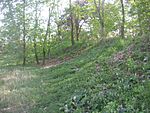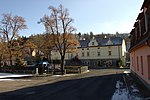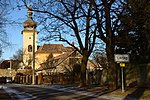Řež
Central Bohemian Region geography stubsNuclear and atomic physics stubsPages with Czech IPAVillages in Prague-East District

Řež (Czech: [ˈr̝ɛʃ]) is a village and administrative part of Husinec in the Central Bohemian Region of the Czech Republic. Řež is the site of a nuclear research centre and a chemical factory. In August 2002 there was a serious flood which damaged the site. Řež has a railway connection by Prague - Kralupy nad Vltavou line. The stop is located on the opposite (left) bank of the Vltava River and is accessible by a pedestrian bridge. On 19 June 2022 the highest ever temperature during the month of June in the Czech Republic was recorded here at 39.0 °C.
Excerpt from the Wikipedia article Řež (License: CC BY-SA 3.0, Authors, Images).Řež
Nad Údolím, okres Praha-východ
Geographical coordinates (GPS) Address Nearby Places Show on map
Geographical coordinates (GPS)
| Latitude | Longitude |
|---|---|
| N 50.1725 ° | E 14.361388888889 ° |
Address
Nad Údolím 118
250 68 okres Praha-východ, Husinec u Řeže
Central Bohemia, Czechia
Open on Google Maps











